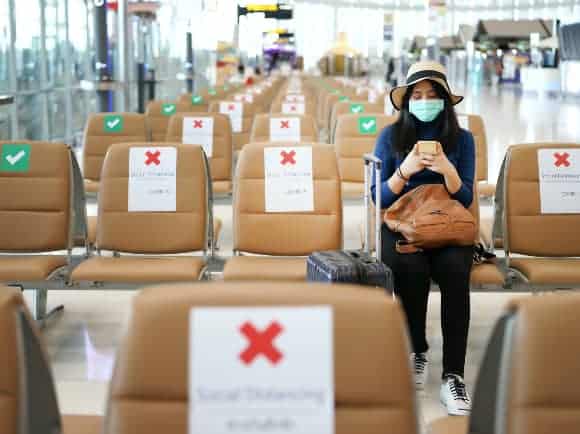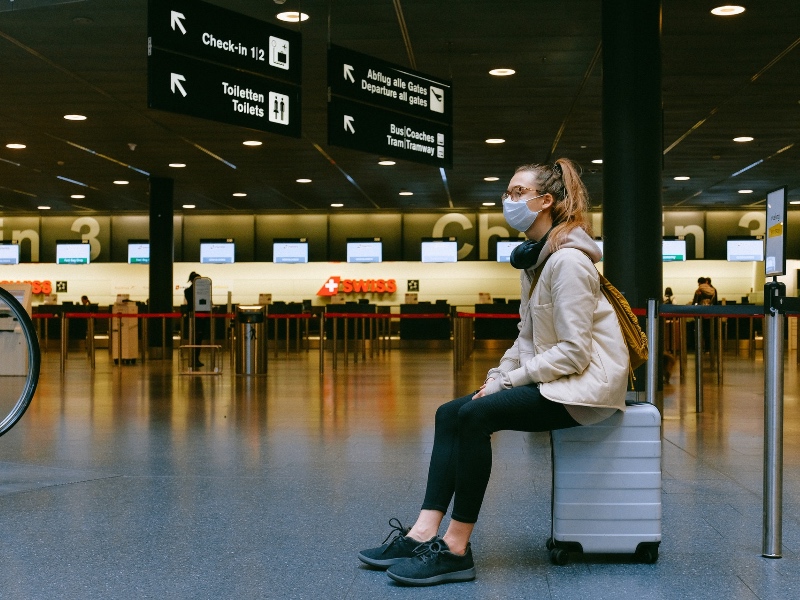Commercial Flights
When travelling from afar, eg. from Africa, Europe, North America or South America, it's quite likely that you will have one transit port or possibly two transit ports enroute.
When travelling from a location closer to Australia, eg. Asia, then you may be able to fly on a non stop flight to Australia, or you will have one transit port enroute.
The airline(s) that carry you from your origin port to a transit port is less important. The airline that carries you from the transit port immediately before Australia to Australia is the airline that you need to pay the most attention to.
For example, you might have an itinerary of:
Frankfurt to Singapore on Lufthansa - the airline that operates this flight is less important
Singapore to Sydney on Singapore Airlines - this is the most important airline/flight to give the most attention to
Below is a list of airlines that are currently flying to Australia for non travel bubble passengers. The below tables only cover airlines that are operating commercial passenger service. Many airlines are operating cargo-only services and these airlines have been omitted. Airlines that only operate travel bubble services have been omitted.
Airlines that operate to intermediate transit ports are not covered below. It is OK to fly an airline not listed below (eg. Lufthansa as per the above example) if it is to an intermediate transit port.
Airlines to look at
[table=collapse]
[tr]
[th]
Airline[/th]
[th]
Code
[/th]
[th]
Frequency
[/th]
[th]
Sydney
[/th]
[th]
Brisbane
[/th]
[th]
Melbourne
[/th]
[th]
Adelaide
[/th]
[th]
Perth
[/th]
[/tr]
[tr]
[td]Aircalin[/td]
[td]
SB
[/td]
[td]
2/week
[/td]
[td]
Yes
[/td]
[td]
-
[/td]
[td]
-
[/td]
[td]
-
[/td]
[td]
-
[/td]
[/tr]
[tr]
[td]Air Niugini[/td]
[td]
PX
[/td]
[td]
3-4/week
[/td]
[td]
Yes
[/td]
[td]
Yes
[/td]
[td]
-
[/td]
[td]
-
[/td]
[td]
-
[/td]
[/tr]
[tr]
[td]All Nippon Airways[/td]
[td]
NH
[/td]
[td]
5/week
[/td]
[td]
Yes
[/td]
[td]
-
[/td]
[td]
-
[/td]
[td]
-
[/td]
[td]
-
[/td]
[/tr]
[tr]
[td]American Airlines[/td]
[td]
AA
[/td]
[td]
Daily
[/td]
[td]
Yes
[/td]
[td]
-
[/td]
[td]
-
[/td]
[td]
-
[/td]
[td]
-
[/td]
[/tr]
[tr]
[td]Asiana Airlines[/td]
[td]
OZ
[/td]
[td]
1/week
[/td]
[td]
Yes
[/td]
[td]
-
[/td]
[td]
-
[/td]
[td]
-
[/td]
[td]
-
[/td]
[/tr]
[tr]
[td]Cathay Pacific[/td]
[td]
CX
[/td]
[td]
> 7/week
[/td]
[td]
Yes
[/td]
[td]
Yes
[/td]
[td]
Yes
[/td]
[td]
-
[/td]
[td]
Yes
[/td]
[/tr]
[tr]
[td]China Airlines[/td]
[td]
CI
[/td]
[td]
Sporadic
[/td]
[td]
Yes
[/td]
[td]
Yes
[/td]
[td]
Yes
[/td]
[td]
-
[/td]
[td]
-
[/td]
[/tr]
[tr]
[td]China Eastern Airlines[/td]
[td]
MU
[/td]
[td]
1/week
[/td]
[td]
Yes
[/td]
[td]
-
[/td]
[td]
-
[/td]
[td]
-
[/td]
[td]
-
[/td]
[/tr]
[tr]
[td]China Southern Airlines[/td]
[td]
CZ
[/td]
[td]
1/week
[/td]
[td]
Yes
[/td]
[td]
-
[/td]
[td]
Yes
[/td]
[td]
-
[/td]
[td]
-
[/td]
[/tr]
[tr]
[td]Delta Airlines[/td]
[td]
DL
[/td]
[td]
Daily
[/td]
[td]
Yes
[/td]
[td]
-
[/td]
[td]
-
[/td]
[td]
-
[/td]
[td]
-
[/td]
[/tr]
[tr]
[td]Emirates[/td]
[td]
EK
[/td]
[td]
> 7/week
[/td]
[td]
Yes
[/td]
[td]
Yes
[/td]
[td]
Yes
[/td]
[td]
-
[/td]
[td]
Yes
[/td]
[/tr]
[tr]
[td]Etihad Airways[/td]
[td]
EY
[/td]
[td]
> 7/week
[/td]
[td]
Yes
[/td]
[td]
-
[/td]
[td]
Yes
[/td]
[td]
-
[/td]
[td]
-
[/td]
[/tr]
[tr]
[td]EVA Air[/td]
[td]
BR
[/td]
[td]
1/fortnight
[/td]
[td]
-
[/td]
[td]
Yes
[/td]
[td]
-
[/td]
[td]
-
[/td]
[td]
-
[/td]
[/tr]
[tr]
[td]Garuda Indonesia[/td]
[td]
GA
[/td]
[td]
1-2/week
[/td]
[td]
Yes
[/td]
[td]
-
[/td]
[td]
Yes
[/td]
[td]
-
[/td]
[td]
Yes
[/td]
[/tr]
[tr]
[td]Japan Airlines[/td]
[td]
JL
[/td]
[td]
2-3/week
[/td]
[td]
Yes
[/td]
[td]
-
[/td]
[td]
-
[/td]
[td]
-
[/td]
[td]
-
[/td]
[/tr]
[tr]
[td]Korean Air[/td]
[td]
KE
[/td]
[td]
1/week
[/td]
[td]
Yes
[/td]
[td]
-
[/td]
[td]
-
[/td]
[td]
-
[/td]
[td]
-
[/td]
[/tr]
[tr]
[td]Malaysia Airlines[/td]
[td]
MH
[/td]
[td]
2-3/fortnight
[/td]
[td]
Yes
[/td]
[td]
-
[/td]
[td]
Yes
[/td]
[td]
Yes
[/td]
[td]
-
[/td]
[/tr]
[tr]
[td]Qatar Airways[/td]
[td]
QR
[/td]
[td]
> 7/week
[/td]
[td]
Yes
[/td]
[td]
Yes
[/td]
[td]
Yes
[/td]
[td]
Yes
[/td]
[td]
Yes
[/td]
[/tr]
[tr]
[td]Scoot[/td]
[td]
TR
[/td]
[td]
Daily
[/td]
[td]
-
[/td]
[td]
-
[/td]
[td]
Yes
[/td]
[td]
-
[/td]
[td]
Yes
[/td]
[/tr]
[tr]
[td]Singapore Airlines[/td]
[td]
SQ
[/td]
[td]
> 7/week
[/td]
[td]
Yes
[/td]
[td]
Yes
[/td]
[td]
Yes
[/td]
[td]
Yes
[/td]
[td]
Yes
[/td]
[/tr]
[tr]
[td]SriLankan Airlines[/td]
[td]
UL
[/td]
[td]
3-4/week
[/td]
[td]
Yes
[/td]
[td]
-
[/td]
[td]
Yes
[/td]
[td]
-
[/td]
[td]
-
[/td]
[/tr]
[tr]
[td]United Airlines[/td]
[td]
UA
[/td]
[td]
Daily
[/td]
[td]
Yes
[/td]
[td]
-
[/td]
[td]
-
[/td]
[td]
-
[/td]
[td]
-
[/td]
[/tr]
[tr]
[td]XiamenAir[/td]
[td]
MF
[/td]
[td]
2/week
[/td]
[td]
Yes
[/td]
[td]
-
[/td]
[td]
-
[/td]
[td]
-
[/td]
[td]
-
[/td]
[/tr]
[/table]
Airlines to avoid
If the airline you are looking at for the flight from the last port before Australia to Australia is not specified in the above table, then that airline is currently NOT operating commercial passenger service to Australia and is unlikely to carry passengers to Australia any time soon.
Avoid these airlines - you will be disappointed.
The airlines not operating commercial flights to Australia include:
Air Canada
Air China
Air India
Air Mauritius
Air Vanuatu
AirAsia X
Batik Air
Beijing Capital Airlines
British Airways
Cebu Pacific
Citilink
Donghai Airlines
Hainan Airlines
Hawaiian Airlines
Indonesia AirAsia
Jetstar Airways
Jetstar Asia Airways
Malindo Air
Philippine Airlines
Qantas Airways
Sichuan Airlines
South African Airways
Thai Airways
Tianjin Airlines
Vietnam Airlines
Virgin Australia
Flights that you might see as operating
Numerous airlines are currently operating cargo only flights to/from Australia. Some airlines are even operating more flights to/from Australia than they were pre-COVID-19.
In many cases, these airlines are operating these flights under the regular passenger service flight numbers as it is easier for an airline to fly a flight if it operates under an already approved flight plan.
The effect of this is you may see flights operating that look like passenger carrying flights on sites like FlightStats, FlightAware, FlightRadar24, airport websites or even Google. As such, it is easy to be fooled into thinking an airline is flying passengers to Australia.
These flights are not carrying passengers.
Codeshare flights
A number of airlines have codeshare agreements with the airlines that do operate passenger service into Australia.
A codeshare flight is where another carrier is given the ability to market and sell the flight as their own flight. Typically these codeshare flights have a 4 digit flight number.
A codeshare agreement is similar to where a retailer may be rebranding a wholesaler's product and selling it as their own. For example, a wholesaler selling blankets may sell their blankets with the default branding as Fred's Blankets. Anne, who operates a retail store selling home items may have an agreement to sell those blankets as Anne's Blankets. It's still the same blanket being sold at the end of the day.
Some examples of airlines who have codeshare agreements with the airlines that do operate passenger service into Australia include:
British Airways (BA) operated by Qatar Airways (QR)
Iberia (IB) operated by Qatar Airways (QR)
Swiss Air (LX) operated by Singapore Airlines (SQ)
Lufthansa (LH) operated by Singapore Airlines (SQ)
Air New Zealand (NZ) operated by All Nippon Airways (NH)
British Airways (BA) operated by Cathay Pacific (CX)
Passengers booked on codeshare flights for the flight from the last port before Australia to Australia generally get bumped/offloaded first by the operating airline.
Avoid these codeshare flights for the flight from the last port before Australia to Australia - you will be disappointed.
You may fly on a codeshare flight for any flight preceding the last flight. This is generally not an issue.
If you are booked on a codeshare flight for the flight from the last port before Australia to Australia, you may wish to consider booking alternative flights.

 www.australianfrequentflyer.com.au
www.australianfrequentflyer.com.au

 www.australianfrequentflyer.com.au
www.australianfrequentflyer.com.au

















